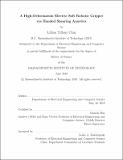| dc.contributor.advisor | Daniela Rus. | en_US |
| dc.contributor.author | Chin, Lillian Tiffany. | en_US |
| dc.contributor.other | Massachusetts Institute of Technology. Department of Electrical Engineering and Computer Science. | en_US |
| dc.date.accessioned | 2019-11-04T19:53:44Z | |
| dc.date.available | 2019-11-04T19:53:44Z | |
| dc.date.copyright | 2019 | en_US |
| dc.date.issued | 2019 | en_US |
| dc.identifier.uri | https://hdl.handle.net/1721.1/122696 | |
| dc.description | This electronic version was submitted by the student author. The certified thesis is available in the Institute Archives and Special Collections. | en_US |
| dc.description | Thesis: S.M., Massachusetts Institute of Technology, Department of Electrical Engineering and Computer Science, 2019 | en_US |
| dc.description | Cataloged from student-submitted PDF version of thesis. | en_US |
| dc.description | Includes bibliographical references (pages 67-72). | en_US |
| dc.description.abstract | This thesis describes the development of a new class of electrically-driven soft robotic actuators built from handed shearing auxetics (HSAs). Soft robots - robots made out of more compliant materials such as rubber and silicone - are significantly more robust and safer than their rigid-bodied counterparts due to their intrinsic compliance. However, existing soft robots are mostly fluid-driven, causing them to be significantly more energy inefficient, susceptible to puncture and limited in controllability. To address these issues, we use HSAs to create compliant actuators without the inherent issues of pneumatic actuation. Through analysis of planar symmetry groups, we add chirality to shearing auxetic patterns, creating materials that expand with a handed bias when pulled in tension. This new metamaterial design enables us to create new structures that have a strong coupling between twisting and extension, letting us use traditional electric-based motors to get linear motion. In this thesis, we explain the theory behind this new class of auxetics, demonstrate how HSAs can be coupled to form compliant linear actuators, and characterize the actuators' performance in a variety of applications. This work culminates in an electrically driven soft robotic gripper which is significantly smaller, more energy efficient and more puncture resistant than existing pneumatic soft robotic grippers. | en_US |
| dc.description.sponsorship | "This work was done in the Distributed Robotics Laboratory at MIT with support from The Boeing Company, Amazon, JD, the Toyota Research Institute (TRI), the NASA Space Technology Research Grant NNX13AL38H, and the National Science Foundation - grant numbers EFRI-1240383, IIS-1226883, CCF-1138967, and #1830901. I was personally supported under the National Science Foundation Graduate Research Fellowship grant #1122374, the Paul & Daisy Soros Fellowship for New Americans, and the Fannie and John Hertz Foundation" | en_US |
| dc.description.statementofresponsibility | by Lillian Tiffany Chin. | en_US |
| dc.format.extent | 72 pages | en_US |
| dc.language.iso | eng | en_US |
| dc.publisher | Massachusetts Institute of Technology | en_US |
| dc.rights | MIT theses are protected by copyright. They may be viewed, downloaded, or printed from this source but further reproduction or distribution in any format is prohibited without written permission. | en_US |
| dc.rights.uri | http://dspace.mit.edu/handle/1721.1/7582 | en_US |
| dc.subject | Electrical Engineering and Computer Science. | en_US |
| dc.title | A high-deformation electric soft robotic gripper via handed shearing auxetics | en_US |
| dc.type | Thesis | en_US |
| dc.description.degree | S.M. | en_US |
| dc.contributor.department | Massachusetts Institute of Technology. Department of Electrical Engineering and Computer Science | en_US |
| dc.identifier.oclc | 1124856194 | en_US |
| dc.description.collection | S.M. Massachusetts Institute of Technology, Department of Electrical Engineering and Computer Science | en_US |
| dspace.imported | 2019-11-04T19:53:43Z | en_US |
| mit.thesis.degree | Master | en_US |
| mit.thesis.department | EECS | en_US |
